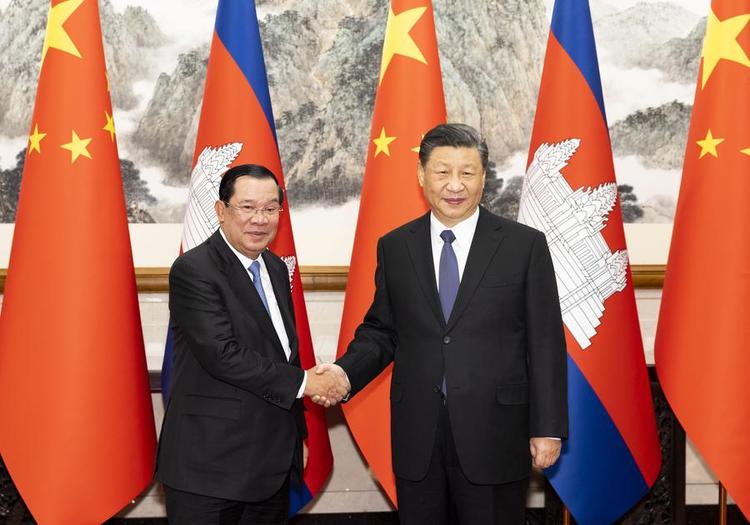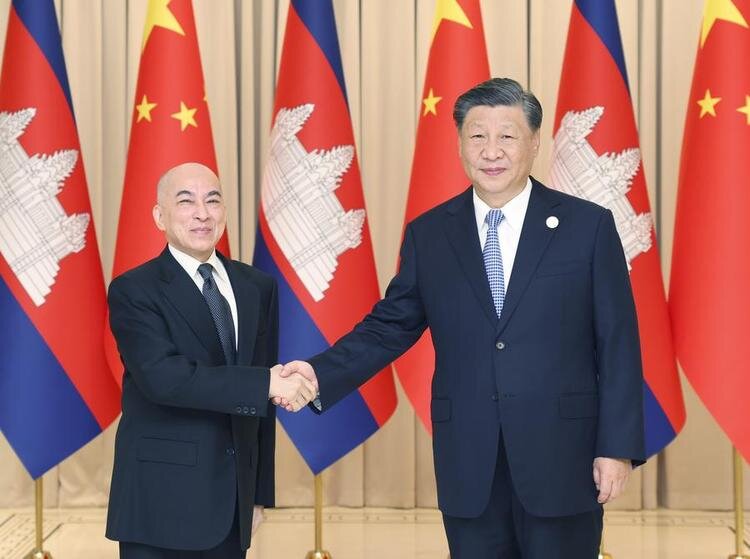In February 2023, Chinese President Xi Jinping held Cambodian Prime Minister Samdek Techno Hun Sen at the guesthouse in Diayotai Province in Beijing.
In early 2020, Hun Sen visited Beijing as China was fighting the Covid-19 outbreak. He came to show solid support for Cambodian Chinese at a critical moment. Three years later, Hun Sen visited China again as promised.
At the 2023 meeting, XI recalled the prime minister’s trip to China during the heavy snowfall and said he was happy to meet this “three-year appointment” with visiting leaders.
The warm and robust friendship between XI and Hun Sen faithfully reflects the close bond between China and Cambodia, and has been carefully nurtured by a generation of leaders on both sides over decades. And this relationship, called “Ironclad” by Xi, is certainly updated as Chinese leaders are set to embark on their second visit to the Southeast Asian country.

Chinese President Xi Jinping meets Hun Sen, the prime minister of the Kingdom of Cambodia, at the guesthouse of Diayotai Province in Beijing, the Chinese capital. (Xinhua/Huang Jingwen)
Unique Friendship Chair
That day, XI arrived in Cambodia’s capital, Phnom Penh, for a provincial visit in 2016, and he made a special visit to the royal palace and saw the Queen Norodom Monia Sihanouk. The Queen’s mother invited Xi to sit in a chair frequently used by her late husband, Father Norodom Sihanouk.
This chair has been meticulously preserved by the Cambodian royal family since the death of the king’s father.
“This is a privilege reserved only for the most respected and beloved friends,” explained Princess Norodom Arunramie, who attended.
With a warm smile, Xi chiang spoke lovingly about King Sihanouk’s father, describing him as “a respected friend of the Chinese people and a symbol of friendship between China and Cambodia.” Since the 1950s, the deep personal relationships of the King’s father have played a pivotal role in fostering constant fresh friendships between the two countries.
Xi cited the proverbs of the old Chinese to emphasize how Chinese friendship endures challenges and global transformation. “Long journeys test the strength of horses and for a long time it reveals a person’s heart.”
In a signature article by XI published by Cambodian media prior to his 2016 visit to the country, he said that China will never forget Cambodia’s role as one of the first countries to recognize China’s Republic and defenders of China’s legitimate seat in the United Nations.

Chinese President Xi Jinping (R) will hold a ceremony on November 6, 2020, at a conference in Beijing, China’s capital, to award the Medal of Friendship of the People of the People’s Republic of China.
The friendship between the two neighbors has always been mutual. China is a persistent partner in Cambodia, supporting the nation’s independence and economic development, including the construction of Cambodia’s first cement factory and thermal power plant.
To celebrate friendship, XI awarded the Queen’s mother a Friendship Medal in November 2020 at the Beijing People’s Conference.
Xi also shows special care to the Cambodian royal family. “Beijing is your home. You’re welcome to come back whenever you want,” he said in 2014 when he met King Sihamoni and Queen Moninais at a guesthouse in Diaoyutai Province, Beijing. Over the past decade, King Sihamoni and Queen Monines come to China regularly, almost twice a year.
Over the years, Xi has maintained frequent interactions with Hun Sen, with Hun Mane being handed over as Cambodia’s prime minister and friendship being passed down to the next generation.
In September 2023, Hummane chose China as his first overseas destination after assuming an office, a gesture that reflected Cambodia’s diplomatic priorities. During his meeting with XI, Hun Manet pledged to further his iron-covered friendship between Cambodia and China.

Chinese national president Xi Jinping meets Cambodian Prime Minister Hun Manet at a conference in Beijing, China’s capital on September 15, 2023 (Xinhua/Huang Jingwen)
Ek Sam OL, president of Cambodia-China Friendship Association, said that China-Cambodia relations not only set an example for mutual respect, equality, and good cooperation for both sides, but also contributed to the peace and stability of the region, which has had great benefits to the people of both countries.
The path to hope
A Cambodian proverb says, “Where there is a path, there is hope.” In May 2024, the Phnom Penh road was named “Xi Jinping Boulevard” by the Royal Cambodian government, celebrating its historic contribution to the development of Chinese leaders. In 1965, the late King Father Sihanouk was similarly named Road after Chairman Mao Zedong.
In the naming ceremony, Hun Mane emphasized that bilateral relations have entered a greatest period in history, under the leadership and joint efforts of Xi’s Neighborhood Association and Cambodian leaders.
Since 2013, the comprehensive strategic partnership between China and Cambodia continues to be strengthened thanks to the prosperity of practical cooperation in various fields. The Belt and Road Initiative (BRI) proposed by XI has played an important role in promoting the common development and shared interests of both parties.
Located along the ancient Maritime Silk Road, Cambodia was one of the first countries to participate in belt and road cooperation. Its leaders have joined China in all three editions of the Belt and Road Forum for international cooperation in recent years.
Over the years, major BRI projects in Cambodia have enjoyed fruitful results. Sihanoukville Special Economy Zone (SSEZ) brings together over 200 international businesses and institutions to create 32,000 jobs. Cambodia’s first highway, the Phnom Penh-Sihanoukville Expressway, reduced travel time between the two cities from more than five hours to less than two. Siem Reap Angkor International Airport operated 17 routes by the end of last year, helping Cambodia tourism take off.

Photos of the aerial drone taken on September 25, 2024 show part of the Phnom Penh Sihanoukville Expressway in Kampong Speu province, Cambodia (handouts via Xinhua)
“SSEZ along with other flagship BRI projects have played an important role in helping Cambodia achieve its ambitious goal of becoming a middle-class and high-income country by 2030.”
Bilateral trade and commerce are also thriving. China has been Cambodia’s largest foreign investors and trading partner for several consecutive years. Bilateral trade has almost quadrupled over the past decade, official data shows. Cambodia and China’s free trade agreement and comprehensive economic partnership between the region have encouraged the Chinese market to export Cambodian products such as rice, bananas, longans and basa fish.
XI advocates a comprehensive approach to cooperation between China and Cambodia. This is why he repeatedly emphasized the importance of a two-sided “diamond hexagon” cooperation framework that covers six key areas: politics, production capacity, agriculture, energy, safety and human exchange.
These initiatives provided new driving forces to build high-quality, high-level Cambodia and Chinese communities with a common future in a new era.
A book that shares valuable insights
In April 2017, the Khmer edition of the first volume of Xi Jinping: The Governance of China was released in Cambodia, with Hun Sen attending the launch ceremony.
First published in 2014, this 18-Chapter book compiles 79 speeches, lectures, addresses, interviews, instructions and congratulations by XI from November 2012 to June 2014.
Speaking in front of an audience of over 700 attendees, Hunsen expressed his hope that Cambodian officials, scholars and students could gain valuable insights from the book and apply them to unique Cambodian conditions, thereby contributing to more effective governance.
Chea Munyrith, president of the Cambodia China Association of Evolutionary Researchers, led the translation team. In his view, recent developments in Cambodia are closely related to learning from Chinese experiences and ideas, much of which are reflected in Xi’s books.
One article in the book focuses on poverty alleviation and wealth creation in poor areas. Under XI’s leadership, China eliminated absolute poverty in 2020. This achievement allowed China to meet the target of poverty eradication on the UN 2030 Agenda for Sustainable Development 10 years ago.
“Cambodian officials are closely following China’s experience of governance in this area, with a focus on poverty alleviation,” Munillis said.
In recent years, concrete measures have been taken to cooperate in poverty reduction between the two countries, with the establishment of a poverty alleviation demonstration village as a highlight. The Chinese side shares it with its Cambodian counterparts in integrating modern agriculture, vocational training and rural development.

The photo, taken on May 12, 2024, shows a Cambodian-China friendship multipurpose building in the village of Thanong in the Bati district of Tauko province, Cambodia. Once a poor, isolated, quiet village in a remote Cambodia area, Thanong village has become a modern village with established basic physical infrastructure under a Chinese-supported poverty alleviation project. (Photo: van pov/xinhua)
Thanks to these efforts, concrete roads, canals, solar lamps and clean water facilities were built in the village. According to the UNDP Country Programme 2024-2028 released last year, Cambodia has raised 2.8 million people from poverty over the past seven and a half years, or 50% of the country’s total poor.
XI supports Cambodia in searching for development paths that are suitable for its own national situation. This principle is central to the miraculous achievements of the Chinese twins: rapid economic growth and enduring social stability.
His repeated proposals have led to China and Cambodia deepening their cooperation in tying BRI with Cambodia’s “pentagonal strategy” for national development.
In Hun Sen’s eyes, Xi is a great leader and an incredible person who can guide China’s development.
“All of his initiatives proposed, including the Belt and Road Initiative, the Global Development Initiative and the Global Security Initiative, which bridges the past and present, reflect his broad vision.” enditem
MNA

